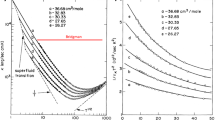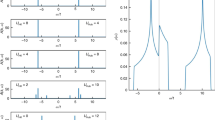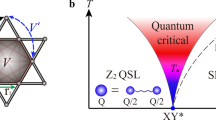Abstract
According to the Green–Kubo theory of linear response, the conductivity of an electronically gapped liquid can be expressed in terms of the time correlations of the adiabatic charge flux, which is determined by the atomic velocities and Born effective charges. We show that topological quantization of adiabatic charge transport and gauge invariance of transport coefficients allow one to rigorously express the electrical conductivity of an insulating fluid in terms of integer-valued, scalar, and time-independent atomic oxidation numbers, instead of real-valued, tensor and time-dependent Born charges.
This is a preview of subscription content, access via your institution
Access options
Access Nature and 54 other Nature Portfolio journals
Get Nature+, our best-value online-access subscription
$29.99 / 30 days
cancel any time
Subscribe to this journal
Receive 12 print issues and online access
$209.00 per year
only $17.42 per issue
Buy this article
- Purchase on Springer Link
- Instant access to full article PDF
Prices may be subject to local taxes which are calculated during checkout




Similar content being viewed by others
Data availability
The data that support the plots within this paper and other findings of this study are available from the corresponding author upon reasonable request.
References
Green, M. S. Markoff random processes and the statistical mechanics of time-dependent phenomena. J. Chem. Phys. 20, 1281–1295 (1952).
Kubo, R. Statistical-mechanical theory of irreversible processes. I. General theory and simple applications to magnetic and conduction problems. J. Phys. Soc. Jpn 12, 570–586 (1957).
Green, M. S. Markoff random processes and the statistical mechanics of time-dependent phenomena. II. Irreversible processes in fluids. J. Chem. Phys. 22, 398–413 (1954).
Kubo, R., Yokota, M. & Nakajima, S. Statistical-mechanical theory of irreversible processes. II. Response to thermal disturbance. J. Phys. Soc. Jpn 12, 1203–1211 (1957).
Baroni, S., de Gironcoli, S., Dal Corso, A. & Giannozzi, P. Phonons and related crystal properties from density-functional perturbation theory. Rev. Mod. Phys. 73, 515–562 (2001).
Resta, R. Electrical polarization and orbital magnetization: the modern theories. J. Phys. Condens. Matter 22, 123201 (2010).
Vanderbilt, D. Berry Phases in Electronic Structure Theory: Electric Polarization, Orbital Magnetization and Topological Insulators (Cambridge Univ. Press, 2018)
French, M., Hamel, S. & Redmer, R. Dynamical screening and ionic conductivity in water from ab initio simulations. Phys. Rev. Lett. 107, 185901 (2011).
Jiang, L., Levchenko, S. V. & Rappe, A. M. Rigorous definition of oxidation states of ions in solids. Phys. Rev. Lett. 108, 1–5 (2012).
Marcolongo, A., Umari, P. & Baroni, S. Microscopic theory and ab initio simulation of atomic heat transport. Nat. Phys. 12, 80–84 (2016).
Ercole, L., Marcolongo, A., Umari, P. & Baroni, S. Gauge invariance of thermal transport coefficients. Low Temp. Phys. 185, 79–86 (2016).
Baroni S., Bertossa R., Ercole L., Grasselli F. & Marcolongo A. in Handbook of Materials Modeling: Applications: Current and Emerging Materials 2nd edn (eds Andreoni, W. & Yip, S.) 1–36 (Springer, 2018).
Helfand, E. Transport coefficients from dissipation in a canonical ensemble. Phys. Rev. 119, 1–9 (1960).
Marcolongo, A. Theory and Ab Initio Simulation of Atomic Heat Transport. PhD thesis, Scuola Internazionale Superiore di Studi Avanzati (2014).
Resta, R. in The Physics of Correlated Insulators, Metals, and Superconductors. Modeling and Simulation Vol. 7 (eds Pavarini, E. et al.) 3.5 (Verlag des Forschungszentrum Jülich, 2017).
Thouless, D. J. Quantization of particle transport. Phys. Rev. B 27, 6083–6087 (1983).
Pendry, J. B. & Hodges, C. H. The quantisation of charge transport in ionic systems. J. Phys. C 17, 1269–1279 (1984).
Resta, R. Quantum-mechanical position operator in extended systems. Phys. Rev. Lett. 80, 1800–1803 (1998).
Rowland T. and Weisstein E. W. Fundamental group. MathWorld–A Wolfram Web Resource http://mathworld.wolfram.com/FundamentalGroup.html (2019).
Kirshenbaum, A. D., Cahill, J. A., McGonigal, P. J. & Grosse, A. V. The density of liquid NaCl and KCl and an estimate of their critical constants together with those of the other alkali halides. J. Inorg. Nucl. Chem. 24, 1287–1296 (1962).
Giannozzi, P. et al. Quantum ESPRESSO: a modular and open-source software project for quantum simulations of materials. J. Phys. Condens. Matter 21, 395502 (2009).
Giannozzi, P. et al. Advanced capabilities for materials modelling with Quantum ESPRESSO. J. Phys. Condens. Matter 29, 465901 (2017).
Perdew, J. P., Burke, K. & Ernzerhof, M. Generalized gradient approximation made simple. Phys. Rev. Lett. 77, 3865–3868 (1996).
Schlipf, M. & Gygi, F. Optimization algorithm for the generation of ONCV pseudopotentials. Comput. Phys. Commun. 196, 36–44 (2015).
Nosé, S. A unified formulation of the constant temperature molecular dynamics methods. J. Chem. Phys. 81, 511–519 (1984).
Hoover, W. G. Canonical dynamics: equilibrium phase-space distributions. Phys. Rev. A 31, 1695–1697 (1985).
Jónsson, H., Mills, G. & Jacobsen, K. W. in Classical and Quantum Dynamics in Condensed Phase Simulations (eds Berne, B. J. et al.) 385–404 (World Scientific, 1998).
Ercole, L., Marcolongo, A. & Baroni, S. Accurate thermal conductivities from optimally short molecular dynamics simulations. Sci. Rep. 7, 15835 (2017).
Janz, G. J., Dampier, F. W., Lakshminarayanan, G. R., Lorenz, P. K. & Tomkins, R. P. T. Molten Salts: Volume I. Electrical Conductance, Density, and Viscosity Data (ed. Astin, A. V.) 48 (US National Bureau of Standards, 1968).
Armand, M., Endres, F., MacFarlane, D. R., Ohno, H. & Scrosati, B. Ionic-liquid materials for the electrochemical challenges of the future. Nat. Mater. 8, 621–629 (2009).
Marcolongo, A. & Marzari, N. Ionic correlations and failure of Nernst–Einstein relation in solid-state electrolytes. Phys. Rev. Mater. 1, 025402 (2017).
Kahle, L., Marcolongo, A. & Marzari, N. Modeling lithium-ion solid-state electrolytes with a pinball model. Phys. Rev. Mater. 2, 065405 (2018).
Resta, R. & Vanderbilt, D. Theory of polarization: A modern approach Physics of Ferroelectrics: A Modern Perspective 51–52 (Springer, 2007).
Acknowledgements
We are grateful to R. Resta for insightful discussions and to R. Bertossa for technical assistance. This work was partially funded by the EU through the max Centre of Excellence for supercomputing applications (project nos. 676598 and 824143).
Author information
Authors and Affiliations
Contributions
Both authors contributed to all aspects of this work.
Corresponding author
Ethics declarations
Competing interests
The authors declare no competing interests.
Additional information
Publisher’s note: Springer Nature remains neutral with regard to jurisdictional claims in published maps and institutional affiliations.
Rights and permissions
About this article
Cite this article
Grasselli, F., Baroni, S. Topological quantization and gauge invariance of charge transport in liquid insulators. Nat. Phys. 15, 967–972 (2019). https://doi.org/10.1038/s41567-019-0562-0
Received:
Accepted:
Published:
Issue Date:
DOI: https://doi.org/10.1038/s41567-019-0562-0
This article is cited by
-
Nonequilibrium molecular dynamics for accelerated computation of ion–ion correlated conductivity beyond Nernst–Einstein limitation
npj Computational Materials (2023)
-
The first-principles phase diagram of monolayer nanoconfined water
Nature (2022)
-
Real-space charge distribution of the cobalt ion and its relation with charge and spin states
Journal of the Korean Physical Society (2021)
-
Heat and charge transport in H2O at ice-giant conditions from ab initio molecular dynamics simulations
Nature Communications (2020)
-
Collective dipole effects in ionic transport under electric fields
Nature Communications (2020)



